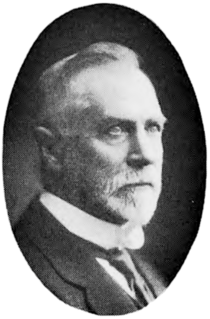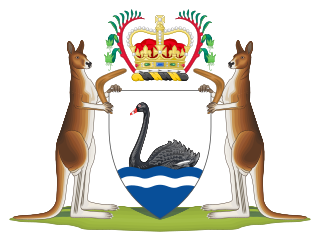The National Labor Party was formed by Australian Prime Minister Billy Hughes in 1916 following the 1916 Labor split on the issue of World War I conscription in Australia. Hughes had taken over as leader of the Australian Labor Party and Prime Minister of Australia when anti-conscriptionist Andrew Fisher resigned in 1915. He formed the new party for himself and his followers after he was expelled from the ALP a month after the 1916 plebiscite on conscription in Australia. Hughes held a pro-conscription stance in relation to World War I.

John Scaddan, CMG, popularly known as "Happy Jack", was Premier of Western Australia from 7 October 1911 until 27 July 1916.
The Electoral district of Brown Hill-Ivanhoe was a Legislative Assembly electorate in the state of Western Australia. It covered part of the Goldfields city of Boulder, near Kalgoorlie, and neighbouring mining areas. It was created at the 1911 redistribution out of the former seats of Brown Hill and Ivanhoe, and was first contested at the 1911 election. It was abolished in the 1948 redistribution, with its area split between the neighbouring electorates of Boulder and Hannans, taking effect from the 1950 election. The seat was a very safe one for the Labor Party.
The 1918 Swan by-election was a by-election for the Division of Swan in the Australian House of Representatives, following the death of the sitting member Sir John Forrest. Held on 26 October 1918, the by-election led to the election of the youngest person to be elected until 2010 to the Parliament of Australia, Edwin Corboy. It saw the conservative vote split between the Country Party and the Nationalist Party, which directly prompted the introduction of preferential voting in Australia.
The Victorian Farmers' Union (VFU) was an association of farmers and primary producers formed in 1914 in the Australian state of Victoria. Although initially formed as an "absolutely non-political" entity, the VFU became a political party in 1916, and nominated candidates for the 1917 state election and subsequent elections. In later years it used the names Victorian Country Party, then United Country Party and is now the National Party of Australia – Victoria. At the 1917 election, because the support for the VFU was concentrated in rural seats, it won four of the 11 seats in the Victorian Legislative Assembly it contested, gaining about 6% of the vote state-wide. In 1918 it also won its first seat in the federal parliament, after preferential voting was introduced. At the 1920 state election the VFU vote increased to 8% and the number of seats to 13, giving the VFU the balance of power in the state Legislative Assembly.
The National Party of Australia (WA) Inc is a political party in Western Australia. It is affiliated with the National Party of Australia but maintains a separate structure and identity.

George James Foley was an Australian politician from Western Australia. He was the member for the Western Australian seat of Mount Leonora from 1911 until 1920, initially for the Labor Party until 1917 when he joined the National Labor Party. He then entered the Federal House of Representatives as the Nationalist member for the seat of Kalgoorlie, which he held until 1922.
This is a list of members of the Western Australian Legislative Assembly between the 1914 election and the 1917 election, together known as the Ninth Parliament. The re-election of Premier John Scaddan's Labor Government with a 26-24 majority in 1914 was tempered when, a year later, Labor member Joseph Gardiner's seat was declared vacant on account of his non-attendance and a Liberal was elected in his stead, and Labor became a minority government when on 18 December 1915, Edward Johnston resigned from the Labor Party and became an independent. On 27 July 1916, the Scaddan Ministry was defeated and the Liberals' Frank Wilson became the new Premier.
This is a list of members of the Western Australian Legislative Council from 22 May 1916 to 21 May 1918. The chamber had 30 seats made up of ten provinces each electing three members, on a system of rotation whereby one-third of the members would retire at each biennial election.
The Electoral district of Subiaco was a Legislative Assembly electorate in the state of Western Australia. The district was named for the inner western Perth suburb of Subiaco, which fell within its borders. It was normally a safe seat for the Liberal Party and its predecessors, but was won on several occasions by Labor in landslide elections.

Elections were held in the state of Western Australia on 29 September 1917 to elect 50 members to the Western Australian Legislative Assembly. The Nationalist-Country-National Labor coalition, led by Premier Sir Henry Lefroy, retained government against the Labor Party led by Opposition Leader Philip Collier. The election followed a series of major changes in the Western Australian political landscape.
This is a list of members of the Tasmanian House of Assembly between the 25 March 1916 election and the 31 May 1919 election. At the 1916 election, no party won a majority, and the Liberals' Walter Lee became Premier of Tasmania. During the term, the Liberal Party converted into the new Nationalist Party, and the Labor Party split over conscription. However, most of the Parliamentary Labor Party stayed with the executive, and the two MHAs who left the Party switched to federal politics. The state of flux, however, resulted in four seats switching from Labor to Nationalist at by-elections and recounts.
The Lefroy Ministry was the 13th Ministry of the Government of Western Australia and was led by Nationalist Premier Sir Henry Lefroy. It succeeded the Second Wilson Ministry on 28 June 1917 due to most members of the former Liberal Party, of which the previous Premier, Frank Wilson, had been the leader, pledging allegiance to the new party. The Lefroy Ministry, which was the first Coalition ministry in Western Australia, was also the only Ministry of a non-Labor government to be chosen by caucus.

The 1917 Victorian state election was held in the Australian state of Victoria on Thursday 15 November 1917 for the state's Legislative Assembly. 51 of the 65 Legislative Assembly seats were contested.
The Australian Labor Party , also known as Victorian Labor, is the semi-autonomous Victorian branch of the Australian Labor Party (ALP). The Victorian branch comprises two major wings: the parliamentary wing and the organisational wing. The parliamentary wing comprising all elected party members in the Legislative Assembly and Legislative Council, which when they meet collectively constitute the party caucus. The parliamentary leader is elected from and by the caucus, and party factions have a strong influence in the election of the leader. The leader's position is dependent on the continuing support of the caucus and the leader may be deposed by failing to win a vote of confidence of parliamentary members. By convention, the premier sits in the Legislative Assembly, and is the leader of the party controlling a majority in that house. The party leader also typically is a member of the Assembly, though this is not a strict party constitutional requirement.

Thomas Hamlet "Tom" Harrison was an Australian politician who was a Country Party member of the Legislative Assembly of Western Australia from 1914 to 1924. He was the leader of the Country Party from 1919 to 1922.
John Henry "Jack" Smith was an Australian politician who was a member of the Legislative Assembly of Western Australia from 1921 to 1936 and again from 1939 to 1943, on both occasions representing the seat of Nelson. He stood for parliament eleven times in total, winning on six occasions.













